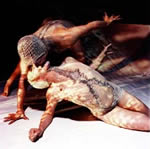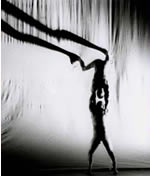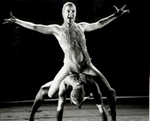
Wild Human Animal : Mouth fastened limpetlike to mouth throughout whirling movements. Like Siamese twins, flowing amoeba-like into and around one another. Crawling like amphibians out of the primeval ooze, evolving through apishness to primitive human and to the tasting of the biblical apple of the Tree of Knowledge.
With their performance of "98.4% DNA. being human" at the Posthof, Teresa Blake and Daniel Witton of
the Australian "desoxy theatre" gave an extremely successful definition of
the concept of dance theatre. When the history of the human animal is interpreted,
clichés are always to be expected. To what extent the familiar can be exciting
depends on the way it is realised. In Blake and Witton the "desoxy theatre" has two versatile protagonists whose repertoire can only be described in superlatives:
exquisite use of speech, outstanding counter and other interludes, extraordinary
movement studies.
Acrobatics, high-order physical control, radicalised elements
of the classical and Martha Graham Schools, garnished with cynical quotations
from the Bible and from microbiology and magnificent lighting (by John Davey).
And when they then absurdly abuse various sex characteristics from physical
urges to death, it is also very entertaining. OÖ Nachrichten, Austria 3.6.00

Words become flesh
Linzer Posthof: The fuse is burning A spot-lit cello, a snare on a pitch-black
stage: a minimum of props. And yet they were used to evoke millions of years
in the history of evolution, from vertebrates to humanoids.
In a brilliant
dance performance on Thursday at the Linzer Posthof, Teresa Blake and Daniel
Witton of the Desoxy Theatre, Australia, showed that mankind, in its claim
to power over nature, is in the process of isolating itself as a species.
Or do they both, man and woman, still have a chance? For the fuse has been
burning relentlessly ever since Homo sapiens conquered fire. Isn't it time
that we realised that we are only one small part of the totality of life,
that the difference between the Wall Street broker and the pygmy chimpanzee
is only 1.6% of their DNA?
With the full commitment of a graceful and powerful
litheness, Teresa Blake and Daniel Witton succeeded impressively in posing
topical questions and underscoring in no uncertain manner the animal side
of our nature.
Contributing to a congruent whole were the sound-mixing (Darren
Steffen) and the lighting (Jon Davey), the texts were deftly humorous and
the set (PJ Rosa) convincing. The only pity was that a large proportion of
the usual Posthof audience managed to miss this enthusiastically received
evening. R. Reichart. Neues Volksblatt, Austria 3.6.00
This clever, two person physical theatre extravaganza may be the best researched
show on the Fringe. Australian co-creators Teresa Blake and Daniel Witton
(who founded their multi-disciplinary company in 1990) have taken as their
central notion the fact that humans and pygmy chimps share a whopping 98.4%
of the same genetic sequencing. In this piece, the physically and mentally
dextrous pair leap far beyond this in order to probe our evolutionary past,
present and future.
Donald Hutera Edinburgh List August 1989

Human bodies can breathe, walk, run, jump, dance, sleep, sing, cry, but in
this production by Desoxy theatre, they can also fly, walk on walls at a 90
degree angle and do all sorts of other surprising things.
Teresa Blake and Daniel Witton's androgynous bodies, head and torso wrapped in net,
re-create a biological evolution of various species leading to that of human
being. They have sound systems in their headgear which they use for vocal
acrobatics, as though their physical acrobatic accomplishments are incomplete
on their own.
Using their own texts as well as some theoretical material from the
internet, Ted Hughes poetry, etc. arranged and complemented by their director
John Britton, Desoxy Theatre creates a unique mediation on the essence of
human life. The drama resides in the conflict between current genetical theories
such as the 'savannah' and the 'aquatic ape' theory.
Knowledge of biology is not a prerequisite for watching this show, however.
The title of the show refers to the fact that the similarity between
chimpanzee and human genetic structure is 98.4%. However, the sheer mastery
and creative genius demonstrated by this company unquestionably disputes this
fact. Duska Radosavijevic, The
Stage, September 98,
London
Deep within the gloom you can just make out two bodies apparently fused together.
They try to tear themselves apart, limbs contorting in the most astonishing
acrobatics. On the soundtrack there are drips and squeaks and gurgles.
From fish to bird to ape to human, this is genetics explained the Australian
way courtesy of Desoxy Theatre,who artfully combine new circus and text,voice
and cello in an effortless physical display of acrobatic dance theatre. You
will get to admire the fake penis,the male canary whose brain size increases
during the mating season, the scubadiver found dead in a forest fire and the
man who wanted to be a fish. But you will also learn about the emotional cost
of being human.
What Desoxy make tangibly manifest in this courageous performance
is 'the body of evidence that bears the scars of evolution'.
Limbs twist, bodies fly through the air and walk up walls, and amidst the
dark primeval sounds the human voice cries out in pure poetry. An emotional
and intellectual assault on sense and the senses.
Saint Brides, Edinburgh. Guardian,
G2 Lyn Gardner,
August 17, 1998

Teresa Blake and Daniel Witton demonstrate the need to cherish and build on
a past that is only six years old. Their
work comes from a distinct dance base but from performance art and new circus
technique. It has an identifiable style and a quirky view of the body's expressive
capabilities. In their new show 98.4% DNA, they roll on , off and into each
other, sing into each other's throats, fly in a harness or swing off a cello
that accompanies movement and speech. It's superb dance theatre built on a
shared and intensely personal vision.
Lee Christofis,
The Weekend Australian 27/28 July 1996
...a trio by desoxy A Hoiting Girl , brought a wise innocent out of piles
of shredded paper and set her spinning words and gestures around her clumsy
elders. Sweet and more noxious than first seems.
But the company's second piece, Being Human,
was wild, dark, witty, feral Theatre. Two mammals (Teresa Blake and Dan Witton)
strain to come together. It's not mating exactly Their encounters are more
visceral than sexual, their body shapes almost ungendered. like predators,
they leap on each other; like parents, they cradle an arm, a head, only to
spring fiercely apart. She throws him up a wall, which he walks along at right
angles to the floor. Then he does the same to her.
Dangerously high, defying
all sense, supported by almost nothing: a salute to family values.
Robin Grove, The
Age 23 July 1997
Acrobatic ideas of evolution
I carry the past
with me, I bear the scars of evolution: from 98.4% DNA -Being human by desoxy
theatre
Teresa Blake
and Dan Witton finish each others sentences. Intercept, intercede, Or sometimes
just extend or amplify the thoughts of the other.
Its as if , conversationally the performance duo who make up desoxy theatre,
their theatre company , mirror the twists and turns of their dynamic physical
performances. This dynamic - both vocally and in performance--also involves
debate, sometimes disagreement, and a negotiation about who is going to speak
first.
The result in discussing their latest work 98.4% DNA - being human inspired
by theories of past and future human evolution, is intriguing. A complex tapestry
of ideas is set up, yet it is one that you can imagine desoxy tackling in
an intelligent and to judge by their previous works, visually stunning manner.
Desoxy first came to light with 'twixt, which was considered the "find"
of the 1990 Melbourne Fringe Festival. In this work on human intimacy, Blake
and Witton touched and held each other, embraced and wrestled, flung and supported
each other in a way that was exceptionally moving. (Blake has a truly awesome
strength, Her support stances with Witton balancing on the muscles of her
back have become a signature of the company.)
For whatever reason, Blake and Witton's duet performances have a poignancy
that, through acrobatics, classical and modern dance, acting and martial arts
tugs at the viewers heart, in the end, their physical strength is able to
convey the vulnerability of being human.
Their latest production was sparked by wondering about how the human
species arrived at it's present state. There are many theories of evolution,
all of which are , in the end, stories and speculations. As such all have
mysteries, gaps and loopholes.
This arena of thought is perfect for theatre, says Blake, 32: "Basically,
these theories are stories which are quite fascinating in themselves. You
can also make up your own, for example, how we might evolve in the future."
Two of these are the "savannah" and the "aquatic ape"
theories say Witton, 27, and Blake. The savannah postulates that the human
species evolved with an evolutionary leap that took it out of a quadripedal
existence as monkeys in tree and on to the savannah plains.
One of the mysteries of this theory, says Blake, is that bipedalism is a strange
adaption and one that would have taken millions of years (for example,
it didn't make escaping from other animals). Part of the show's title, the
98.4%, comes from the DNA similarities humans share with chimpanzees.
One possible cause for bipedalism is discussed in the "aquatic ape"
theory; taking refuge in water may have inspired the pre human animal to go
up on two legs. This theory proposes that humans have had an aquatic or semi
aquatic phase.
A combination of text drawn from many sources, sound and music (created by
Darren Steffen) and dance is used to narrate and comment on different evolutionary
theories.
There is no set, just simple rope devices. "We decided to put the complexity
into the aural landscape rather than the visual", says Blake.
The possible processes of evolution, and it's "scars", can also
be seen as a metaphor for the experience of each life today, says Witton,
is "that we may be able to find out the oldest secrets of our development
by looking at ourselves as living time capsules...We're not the final draft."
"Or mutation," adds Blake
Jacinta le Plastrier, The Age, July 1996